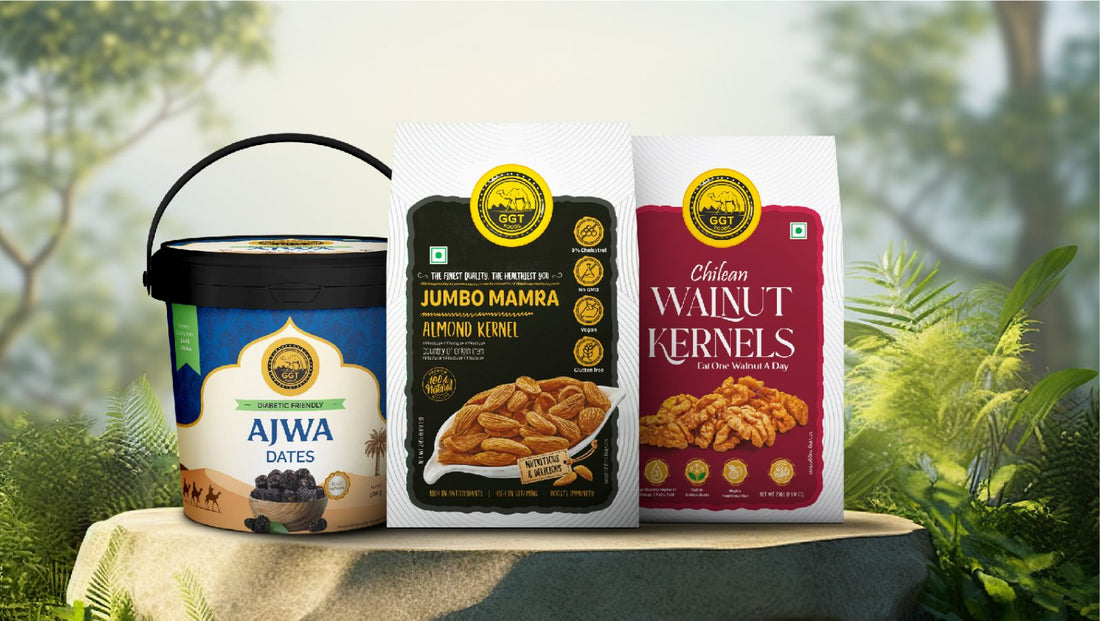Can people with diabetes really enjoy dry fruits without worrying about sugar spikes? Absolutely—when chosen wisely! While it’s true that some dried fruits are naturally high in sugar, there are several nutrient-rich dry fruits for diabetes that not only satisfy your cravings but also help regulate blood sugar levels. In this blog, we’ll explore the best dried fruit for diabetics, how they support your health, and the smartest ways to consume them daily without going overboard.
Can Diabetics Eat Dry Fruits?
Yes, diabetics can eat dry fruits—but moderation and the right choices are key. Dry fruits for diabetic patients can be a healthy snack option, as many are rich in fiber, healthy fats, and essential nutrients that support blood sugar control.
Top 5 Importance of Eating Dry Fruits for Diabetics
Including dry fruits for diabetes in your daily diet can offer several health benefits, especially when you choose the right ones. Here are the top five reasons why dry fruits for diabetic patients can be a smart dietary choice:
-
Helps Regulate Blood Sugar Levels
Certain low sugar dry fruits like almonds, walnuts, and pistachios have a low glycemic index and are rich in fiber, which helps slow down sugar absorption and stabilize blood glucose levels.
-
Rich in Nutrients Without Added Sugar
Diabetic friendly dry fruits are packed with essential vitamins, minerals, and antioxidants. When consumed in their natural, unsweetened form, dried fruit for diabetics can boost overall health without spiking blood sugar.
-
Supports Heart Health
Many dry fruits for sugar patients, such as walnuts and almonds, contain healthy fats that reduce bad cholesterol and improve heart health—an important factor for those managing diabetes.
-
Promotes Satiety and Weight Management
Dry fruits for diabetic patients are rich in protein and fiber, which help control hunger and prevent overeating, aiding in weight management—a key aspect of diabetes control.
-
Provides a Healthy Snack Option
Wondering, can diabetics eat dry fruits as snacks? Absolutely—when chosen wisely. Low sugar dry fruits offer a convenient, nutritious alternative to sugary treats, making them ideal dry fruits for diabetes management.
By selecting dry fruits for sugar patients carefully and eating them in moderation, diabetics can enjoy both taste and health benefits without compromising their blood sugar goals.
Incredible Dry Fruits For Diabetic Patients
When it comes to dry fruits for diabetic patients, Mamra almonds and walnuts stand out as three of the most powerful and beneficial options.
Mamra Almonds
Known for their superior quality and natural richness, Mamra almonds are a powerhouse of healthy fats, vitamin E, and magnesium. They have a low glycemic index, which means they release sugar slowly into the bloodstream—helping maintain stable glucose levels. The high fiber content also promotes better digestion and longer satiety, reducing cravings for unhealthy snacks. For dry fruits for diabetes, Mamra almonds are especially recommended due to their unprocessed, nutrient-dense nature.
Walnuts
Walnuts are among the most recommended diabetic friendly dry fruits due to their high content of omega-3 fatty acids, antioxidants, and plant-based protein. They support heart health—crucial for diabetics—reduce inflammation, and improve insulin sensitivity. Eating walnuts regularly has been linked to better metabolic health, making them a smart inclusion in any diabetic diet.
Ajwa Dates
While most dates are high in natural sugars, Ajwa dates are considered a better option among them due to their lower glycemic index and rich nutritional profile. Known for their medicinal value and antioxidant properties, Ajwa dates are a source of natural fiber, potassium, magnesium, and essential nutrients that support heart and digestive health.
How Much to Eat Daily?
Portion control is key for dry fruits for sugar patients. Here’s a safe daily serving size:
- Mamra almonds: 6–8 pieces
- Walnuts: 2–4 halves (1–2 whole walnuts)
- Ajwa Dates : 4-5 pieces
This quantity ensures you get the benefits of dried fruit for diabetics without causing blood sugar spikes.
Summing Up!
Incorporating the right dry fruits for diabetes into your daily routine can support better blood sugar control, improve heart health, and keep you feeling fuller for longer. From Mamra almonds to walnuts, choosing low sugar dry fruits in moderation makes a real difference for diabetic health. Always go for quality, unsweetened options.
Looking for premium diabetic-friendly dry fruits? Explore GGT Foods’ range of natural and wholesome dry fruits today!
Frequently Asked Questions
Q: How to use dry fruits for diabetes?
A: To use dry fruits for diabetes effectively, choose low sugar dry fruits like almonds, walnuts, pistachios, and peanuts. Eat them in small portions (a handful per day), preferably raw and unsalted. You can consume them as a mid-meal snack, add them to salads or oatmeal, or pair them with yogurt for a balanced mini-meal. Avoid sugar-coated or processed varieties, and always monitor portion size to avoid unnecessary calorie intake.
Q: How to eat anjeer for diabetes?
A: Anjeer (dried figs) can be eaten in small amounts by diabetics due to its fiber content, which helps slow sugar absorption. Soak 1–2 dried figs overnight and eat them in the morning on an empty stomach. This makes the fiber more digestible and the natural sugars easier to manage. However, since anjeer is moderately high in sugar, it should be consumed occasionally and in controlled quantities.
Q: Which dry fruit is best for a sugar patient?
A: Almonds and walnuts are among the best dry fruits for diabetic patients. They are rich in healthy fats, fiber, and antioxidants, with a low glycemic index—making them ideal dry fruits for sugar patients. Mamra almonds, in particular, offer excellent nutritional value with no added processing, while walnuts support heart health and improve insulin sensitivity.




![GGT Irani Mamra Almond Oil [Wood Pressed Oil]](http://www.ggtfoods.com/cdn/shop/files/Irani_Mamra_Almond_Oil_150x.png?v=1749116821)

















